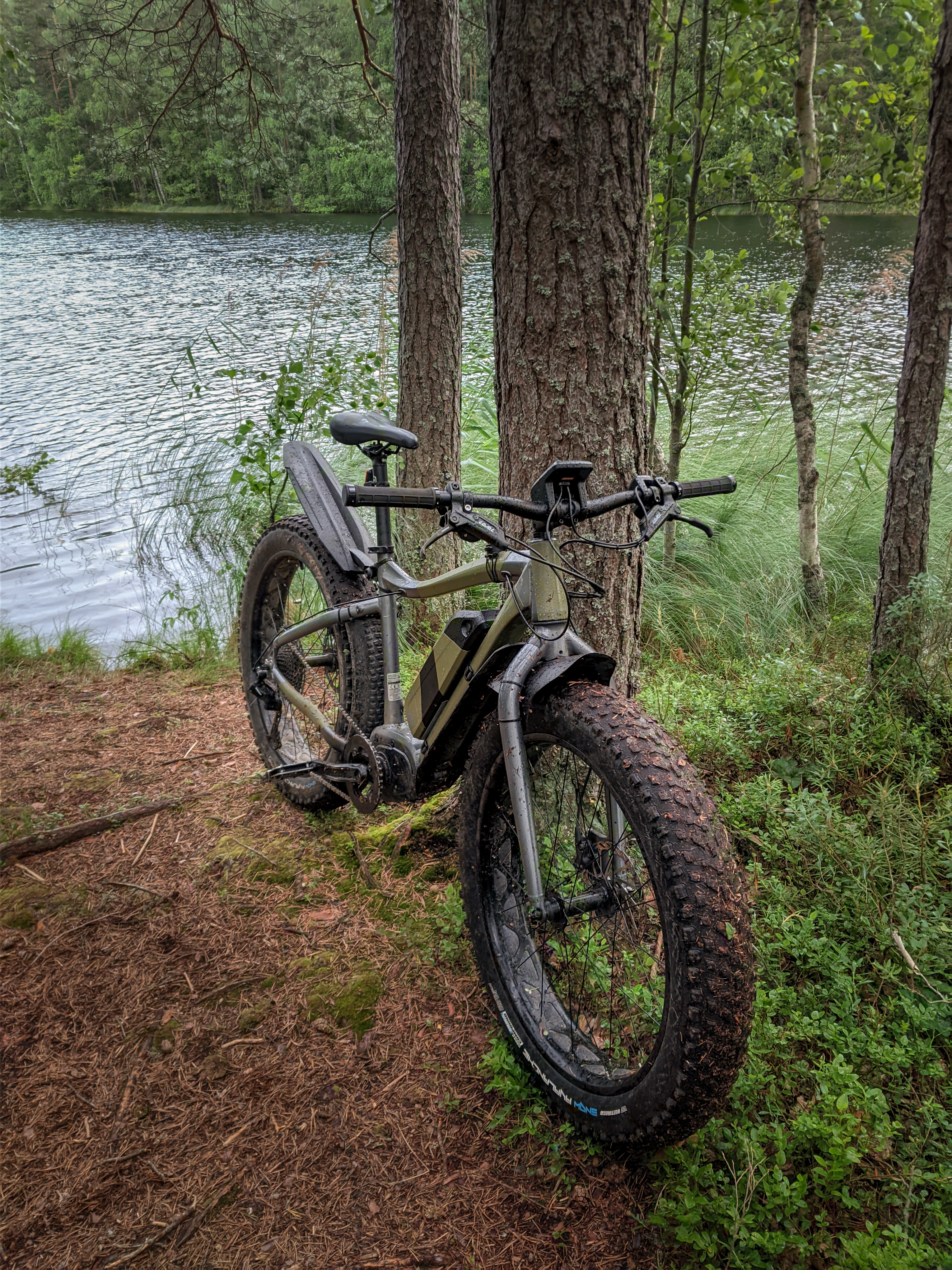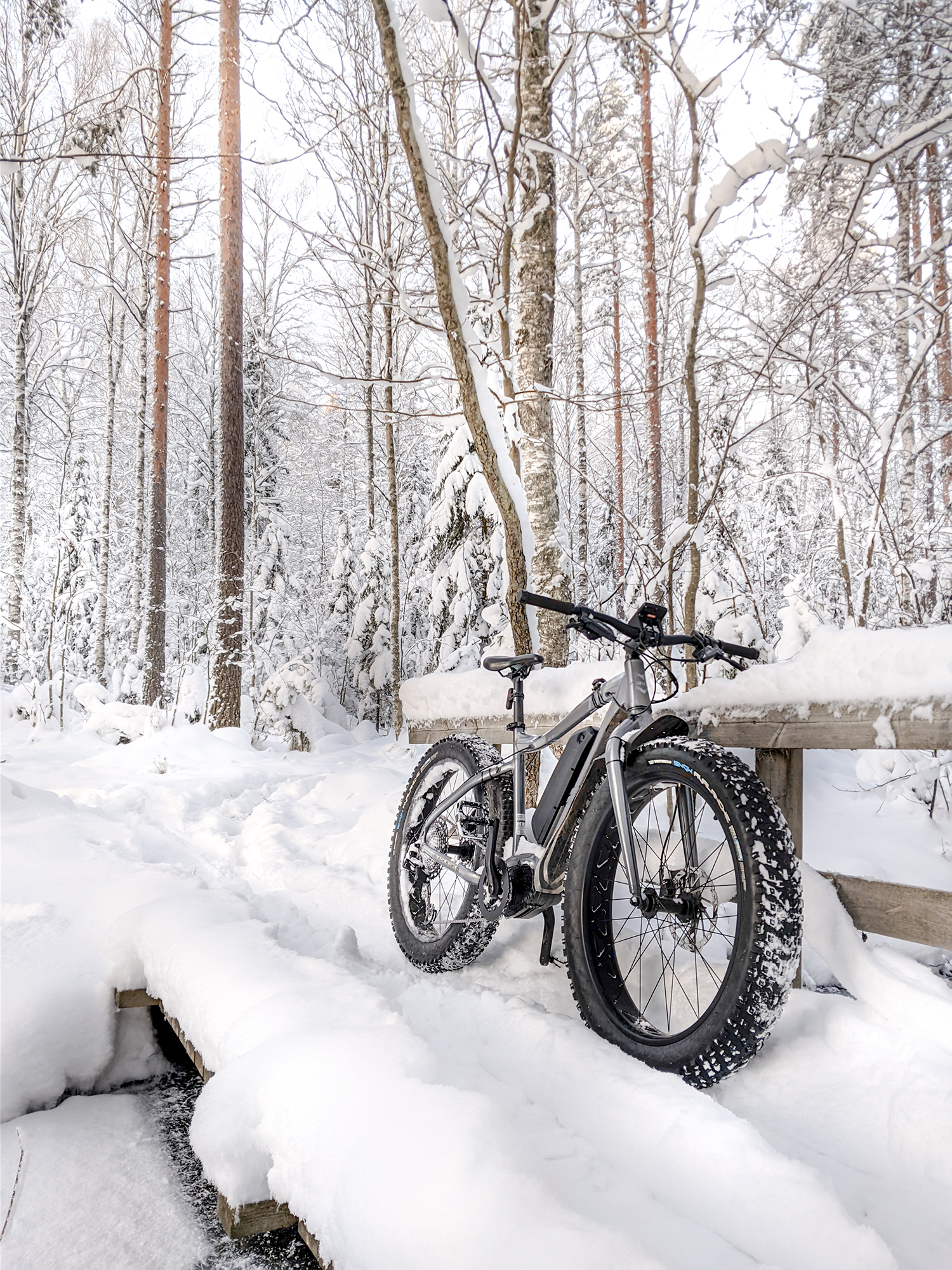For me, I’ll be using my 90s steel MTB.
I’ve already coated the inside of the frame with anti rust, got a rust resistant chain, and have studded tires at the ready. The studded tires will only go on if there’s persistent icy conditions.
Packed marine grease into my hubs, bb ends, and headset bearings.
On my todo list, I’ll be installing pogies/bar mitts, which have proven to be way better than any glove solution I tried last winter.
I also want to buy/make a mudflap to expend the front fender. This should prevent a considerable amount of grit, salt, melted snow from reaching my shoes, chain, crankset, etc.
As soon as salt goes down, my bike will get more cleaning around critical parts, and a frame wipe down after every ride.
I do have a winter cycling jacket and fleecy cycling pants, but feeling the cold on my body was never an issue last winter. A fleecy buff and helmet liner that gets over my ears are a must, and i may invest in a few extra pairs.
If you live in cold climate, buy skiing gear. Skiing pants, midlayers, jackets, face masks are all geared to freedom of movement, high insulation and breathability. All things you’d want while biking.
Interesting! That’s a great tip.
Hands and cold protection are critical. Have you tested gloves? What brand and model?
For my bike: more frequent hand washing, then additional chain cleaning. A little more universal lubricant, like WD-40, and standard bicycle chain oil.
Just in case you or others didn’t realise, WD-40 isn’t a true lubricant. It is actually a solvent. Although it works as a lubricant in many cases, the effects are short lived (and shouldn’t be used to lubricate some things like locks as the will gum up).
This is true about the standard Wd-40 spray (WD = Water Displacement). However, the company did make 2 different actual chain lubes. One for wet, one for dry, and those work amazingly.
Yup. I use the WD-40 degreaser (just easier to get), but also have used their wet and dry lube.
My preference for lube, however, has gone from the WD-40 lube to Wolftooth to Silca Synergetic (highly recommended!).
Oh cool. Thanks for the info!
Multilube similar to WD-40 is all I use on my chain. During summer time I apply it every 4th ride or so and in winter time or when it’s just wet in general I use if after the ride to get rid of the moisture. I always wipe with a rag afterwards. Now my chain stays clean and shiny all the time unlike before when I used a proper chain lube which just collects dirt and still doesn’t protect the chain from rust after it gets wet.
Have you tested gloves? What brand and model?
All kinds, and they just got bulkier and more awkward to use the brakes/shifters. I haven’t tried any lobster claw gloves, however, but they also seem too bulky for my liking. Not even heated gloves were as effective as pogies!
With pogies, my hands get so warm that I can quite literally either ride without any gloves or glove liners at most. LOL
Not riding in winter means not riding for third of the year. Not gonna happen.


First tip: Live in Chicago. Mild winters, aggressive plowing, very flat.
Second tip: Take care of your brakes, ride slower, know how to stop in icy conditions.
Gear: Avoid cotton. Lots of layers. You’ll get hot and need to vent your core. Getting sweaty is dangerous. Gloves, get a pair 9f warm but skintight smartphone-compatible gloves and a big pair of waterproof-shell mitts to wear overtop. Your boots should also be waterproof. Some kind of rear fender or guard on the bike to prevent splatter up the back.
And bright, bright colors. Visibility is worse in winter, you can’t afford to be invisible.
I’m all about high-viz, so I’ve got that covered!
I didn’t need boots last winter, but did need shoe covers a few times, just to cut the windchill. I do have boots at the ready if needed!
- winter tires (no studs—they might be nice on those very icy days, but I didn’t fancy changing tires)
- ski goggles, with a very light tint since it’s often dark (sunglasses won’t do, they fog up too easy)
- helmet liner (down to -10C), or balaclava on colder days
- regular gloves (above 0C), izumi lobster gloves (ok down to -5C or -10C), or ozero long-sleeve ski/shoveling mitts (colder days). I’ve thought about pogies, but with the bike parked outside I didn’t want to have to take them on/off the bike every time. Mitts make it harder to reach shifter and brake, but the ice/slush build-up limited the gear shift to just a few options anyway, and slow, planned braking works better on ice.
- waterproof shell/pants. Not only to stay dry and keep clothes clean, but it cuts the wind too.
- thermal underclothes (only on colder days)
- scarf to cut the wind on my lower face (less cold days), or switch to a full balaclava on very cold days.
- waterproof winter hiking boots
- hose and wipe down bike as needed
- also planning on carrying lock deicer this year, as last year the bicycle lock almost wouldn’t open a few times after sitting outside in the weather all day.
ski goggles, with a very light tint since it’s often dark (sunglasses won’t do, they fog up too easy)
Which ones are you using? I’m looking and they all seem really bulky.
Yes, they are all kind of bulky, but as long as they don’t interfere with a helmet and give good peripheral vision I figured that was just an aesthetic concern. I went with “ZIONOR Lagopus Ski Snowboard Goggles” (B-clear blue lens, 60% cloudy/night). They have been comfortable, don’t fog up, and aren’t too dark (could’ve gone for a bit darker for daytime, but in the winter I’m often cycling at dusk/dawn). On the down side, there’s still some minor distortion in the lenses (not enough to bug me, but sometimes noticeable), and they tend to press on the bridge of my nose a bit more than I would like (causing a tendency to mouth-breathe). If you can try some out in a store then that would probably be better.
I appreciate the reply. I’ve been wearing standard cycling glasses, but the lenses are a little longer, with my helmet liner down to my eyebrows and a buff up my face and just behind the bottom of the lenses. This worked for me last year, but keeping my ears warm was always a challenge. I do have some thicker helmet liners with ear coverings, so that should be much better.
Lens tints drove me crazy on my other cycling glasses… too dim for bright sun and too dark for cloudy or darker. I’ve been EXTREMELY happy with photochromatic (i.e. transition) lenses, and if there’s a way to get something like that with your Zionor goggles, I think it would make a world of difference. I can wear them at night (for wind and bug protection) or during full sun. Granted, they aren’t ideal for extremely bright sun as they don’t get too dark, but coupled with a helmet visor/cycle cap visor, it’s a good combo.
I mean this response isn’t helpful in any way, but as a Canadian who bikes to work, I just use my beater fixed gear. As long as you maintain momentum it works great in up to 4 inches of snow, the fixed gear really seems to help with maintaining balance on ice though. No special modifications, no studs, regular road tires. The comment about layering is right on the money, I usually wear a zip Hoodie and a Jean jacket, both undone to allow for airflow.
I’ve been so tempted to get a single speed bike (not a fixie, though, as i like coasting).
Unfortunately, between the hills and cargo I tend to haul, I do need multiple gears.
This winter will be my third biking and here are a few learnings I’ve had:
- No need for studded tires most of the time. I ride an old 26er with pretty big knobby tires and have a separate front wheel (which cost me 10$ if I remember right) with a studded tire for days that require it.
- Keep your setup simple. I use a 1x9 gearing with a narrow-wide chainring to keep chain drops to a minimum. I’ve also heard lots of positive of riding single speed/fixed gear.
- Mud guards.
- Don’t overdress. This will be something you’ll learn along the way, depending on your own tolerance to cold, but you don’t need to wear a full winter jacket. In Montreal where I ride, I normally just wear merino wool base layers with waterproof pants and shell. Where you want to concentrate your efforts are hands and feet.
I like the idea of having a front wheel to swap out. I may try this, since I really would rather not run studded if i dont absolutely need to. They tend to be overkill for 90% of the outings i take during the winter, but i guess it also depends on the winter. Some of our paved trails become slick with ice and can be quite dangerous to walk or ride on.
No need for studded tires most of the time.
That depends a lot on your local conditions. Studded tires work great on black ice, when nothing else does. I will concede that stubby mountain bike tires do well in the snow.
I ride a Breezer Uptown 8, which has fenders, a full chain case, and a Shimano Nexus 8 hub. For winter riding, I put on winter tires. That’s about all the preparation it takes. I’ve had an Uptown for about 6 years, and had to lubricate the chain approximately 4-5 times.
I used to ride a bike with the usual derailleur-based 21 gears, but never again! Changing the rear tire is a pain and a half due to the chain case, but it’s a twice a year thing, compared to cleaning and lubing and exposed chain every few days, and then replacing the chain, cassette and rings every year or two anyway.
Why aren’t chain cases a thing in the U.S.?
Why aren’t chain cases a thing in the U.S.?
Because they are seen as feminine and weak. Machismo requires shunning fenders and chain cases - serious riders can’t afford the weight and are too strong and powerful to be concerned with water, muck, and bike component longevity!
I’m being kind of sarcastic, but really that’s what it boils down to. Sort of the same reason you don’t see station wagons anymore, but truck cabs have expanded to the point that truck beds are minuscule and are pretty much decorative and can’t carry anything. Real Men don’t drive station wagons or minivans, that’s emasculating!
It’s been interesting watching the swing in attitude from ebikes being seen as only for wimps, to now they are powerful tools to assert dominance on the bike path. I would imagine we will see a similar swing with some of the old-school bike tech. (Ryan van Duzer is making internal hubs cool again, at least to a subset of adventure riders. Or people who want to be perceived as adventure riders…)
Not just a winter tip but hub dynamo & dynamo lights if you cycle in dark, also full-length metal fenders for all the wet and muddy and snowy conditions. If it gets really cold consider using plastic or composite pedals instead of metal. Oh and there’s some special grease made by Shimano that is supposed to prevent cables from freezing, but wet lube inside the housing works as well.
I’d love to get a dynamo system one day, but I’m quite happy with my front and rear light options (I’ve got quite a few).
I had plastic pedals on one of my bikes, but it got too slippery when they were wet. I’m happy with my pedals, but I likely will make more use of my shoe covers this year and only needed them once last year on a 50km+ ride when it was probably too cold to be out. LOL
My touring bike is already equipped for wet weather and heavy enough to grip a frost. Will just get it serviced when the weather improves
Gonna have to since that’s how we’re getting our daughter to and from nursery. Usually fine with winter gloves and jacket.
I’ll be putting my summer bike on the trainer though.







